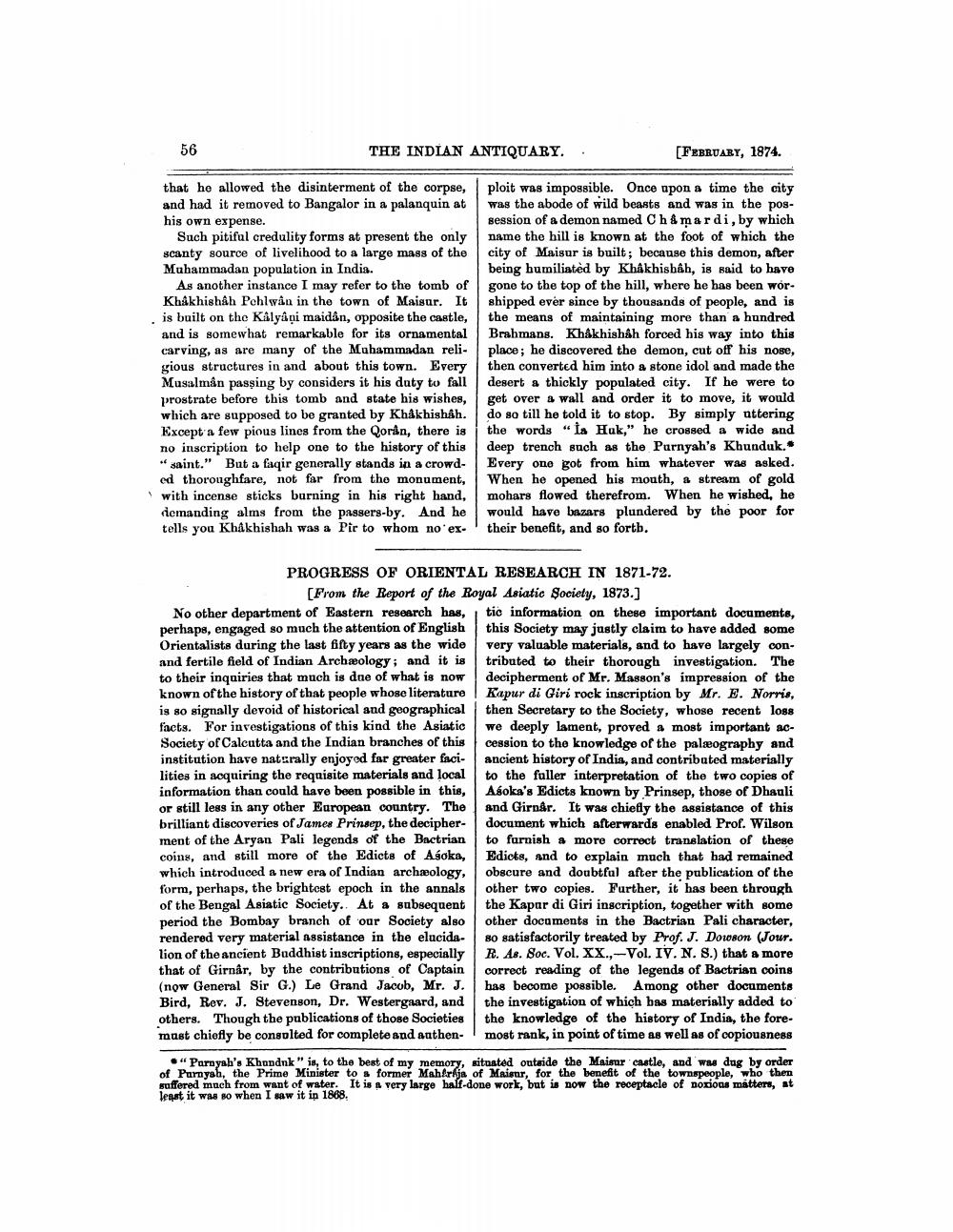________________
56
THE INDLAN ANTIQUARY..
[FEBRUARY, 1874.
that he allowed the disinterment of the corpse, and had it removed to Bangalor in a palanquin at his own expense.
Such pitiful credulity forms at present the only scanty source of livelihood to a large mass of the Muhammadan population in India.
As another instance I may refer to the tomb of Khakhishah Pehlwan in the town of Maisur. It is built on the Kalyani maidan, opposite the castle, and is somewhat remarkable for its ornamental carving, as are many of the Muhammadan religious structures in and about this town. Every Musalman passing by considers it his duty to fall prostrate before this tomb and state his wishes, which are supposed to be granted by Khåkhishah. Except a few pious lines from the Qoran, there is no inscription to help one to the history of this "saint." But a faqir generally stands in a crowded thoroughfare, not far from the monument, with incense sticks burning in his right hand, demanding alms from the passers-by. And he tells you Khåkhishah was a Pir to whom no.ex.
ploit was impossible. Once apon a time the city was the abode of wild beasts and was in the possession of a demon named Chamardi, by which name the hill is known at the foot of which the city of Maisur is built; because this demon, after being humiliated by Khâkhishah, is said to have gone to the top of the hill, where he has been wor. shipped ever since by thousands of people, and is the means of maintaining more than a hundred Brahmans. Khåkhishah forced his way into this place; he discovered the demon, cut off his nose, then converted him into a stone idol and made the desert a thickly populated city. If he were to get over a wall and order it to move, it would do so till he told it to stop. By simply uttering the words "La Huk," he crossed a wide and deep trench such as the Parnyah's Khunduk. Every one got from him whatever was asked. When he opened his mouth, & stream of gold mohars flowed therefrom. When he wished, he would have bazars plundered by the poor for their benefit, and so forth.
PROGRESS OF ORIENTAL RESEARCH IN 1871-72.
[From the Report of the Royal Asiatic Society, 1873.] No other department of Eastern research has, tic information on these important documents, perhaps, engaged so much the attention of English this Society may justly claim to have added some Orientalists during the last fifty years as the wide very valuable materials, and to have largely conand fertile field of Indian Archæology and it is tributed to their thorough investigation. The to their inquiries that much is due of what is now decipherment of Mr. Masson's impression of the known of the history of that people whose literature Kapur di Giri rock inscription by Mr. E. Norris, is go signally devoid of historical and geographical then Secretary to the Society, whose recent loss facts. For investigations of this kind the Asiatic we deeply lament, proved & most important acSociety of Calcutta and the Indian branches of this cession to the knowledge of the palæography and institution have naturally enjoyed far greater faci- ancient history of India, and contributed materially lities in acquiring the requisite materials and local to the fuller interpretation of the two copies of information than could have been possible in this, Aboka's Edicts known by Prinsep, those of Dhauli or still less in any other European country. The and Girnar. It was chiefly the assistance of this brilliant discoveries of James Prinsep, the decipher- document which afterwards enabled Prof. Wilson ment of the Aryan Pali legends of the Bactrian to furnish a more correct translation of these coins, and still more of the Edicts of Asoka, Edicts, and to explain much that had remained which introduced a new era of Indian archæology, obscure and doubtfal after the publication of the form, perhaps, the brightest epoch in the annals other two copies. Further, it has been through of the Bengal Asiatic Society. At & subsequent the Kapar di Giri inscription, together with some period the Bombay branch of our Society also other documents in the Bactrian Pali character, rendered very material assistance in the elucida. Bo satisfactorily treated by Prof. J. Dowson (Jour. lion of the ancient Buddhist inscriptions, especially R. As. Soc. Vol. XX.,-Vol. IV. N. S.) that a more that of Girnar, by the contributions of Captain correct reading of the legends of Bactrian coins (now General Sir G.) Le Grand Jacob, Mr. J. has become possible. Among other documents Bird, Rev. J. Stevenson, Dr. Westergaard, and the investigation of which bas materially added to others. Though the publications of those Societies the knowledge of the history of India, the foremust chiofly be consolted for complete and authen- most rank, in point of time as well as of copiousness
" Parnyah's Khanduk" is, to the best of my memory, situated outside the Maisur castle, and was dug by order of Paravah, the Prime Minister to s former Maherkja of Maisur. for the benefit of the townspeople, who then suffered much from want of water. It is a very large half-done work, but is now the receptacle of porious matters, at least it was so when I saw it in 1868.




